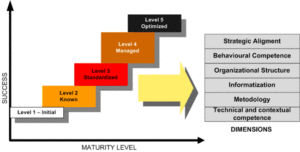Modelo Prado MMGP
FOUNDATIONS OF PRADO PM MATURITY MODEL
Below is a summary text of the basic characteristics of the maturity model Prado-MMGP. Wishing read the full text, click here.
The Departamental Prado-MMGP Model

The Prado Project Management Maturity Model (Prado-PMMM) is based on the experience of consultant Darci Prado in a world-class organization (IBM) and also in college and other consulting works for INDG. Darci has more than 30 years of management experience and had the opportunity of getting involved in many different project typed, from construction, information technology, new product development to equipment installation. He has helped tenths of brazilian organizations to structure themselves for the challenge.
The objective of the Departamental Prado-PMMM model, which was used on this survey, is to evaluate the maturity of an organization’s departament or sector. It has the following characteristics:
– 5 different levels and 7 dimensions
– Considers processes, people, technology and strategy
– Adheres to PMBOK (PMI) and ICB (IPMA) Levels and dimensions
Levels and dimensions


DIMENSIONS
| Competence in Project and Program Management |
| Competence in Technical and Contextual Aspects |
| Behavioral Competence |
| Methodology usage |
| Computerization |
| Usage of the convenient Organizational Structure |
| Strategic Alignment |
The levels shown on the image above are:
Level 1 – Initial
Level 2 – Known
Level 3 – Standardized
Level 4 – Managed
Level 5 – Optimized
Dimensions are:
1. Competence in Project and Program Management
2. Competence in Technical and Contextual Aspects
3. Behavioral Competence
4. Methodology usage
5. Computerization
6. Usage of the convenient Organizational Structure
7. Strategic Alignment
Each level can contain up to 7 maturity dimensions, each one in a different degree and in a specific way. The text below shows a brief summary of the levels:
Level 1
The company does not have a correct perception of what projects and project management are. Projects are executed on the basis of intuition, «goodwill» or «best individual effort». Usually there is no planning, and control is always nonexistent. There are no standardized procedures. The success is the result of individual effort or luck.
Level 2
This level represents the awakening to the subject of PM. Its main features are:
– Introductory knowledge of Project Management.
– Introductory use of tools (software) for activities sequencing.
– Isolated initiatives for planning and control of some projects.
– Each professional works in its own way, as the consequence of the lack of a standardized platform for PM, consisting of processes, tools, organizational structure, etc.
– Is the awakening of an awareness of the importance of implementing each of the components of a project management platform.
Level 3
This level represents the situation where a PM platform has been implemented. Its main features are:
– Existence of a standardized platform for PM (see Figure 6 above).
– The platform is in use by the leading players for over one year.
– Use of baseline and performance measurement.
– Data capture of anomalies that impact project results (delays, cost overruns, etc.).
– Evolution in skills.
Level 4
This level represents the situation where the PM platform really works and gives results. Its main features are:
– Elimination (or mitigation) of manageable anomalies that hinder project outcomes.
– Professionals consistently demonstrate a high level of competence.
– The results of the area (success rate, delay, etc.) are consistent with that expected for the maturity level 4.
Level 5
This level represents the situation in which the PM platform not only works and gives results as was also optimized by the practice of continuous improvement and technological and processes innovation. Its main features are:
– Optimization of processes and tools.
– Optimization of results (time, cost, scope, quality, performance, etc.).
– Highest level of success.
– Efficiency in the environment and work climate, high productivity and low stress.
– High recognition of the competence of the area, which is seen as a benchmark.
Reference

For further information on the Prado-PMMM, check the book:Prado, D, «Maturidade em Gerenciamento de Projetos » (not released in english yet)
3nd Edition – Published by INDG-Tecs, 2010. This book can be bought at www.editorafalconi.com